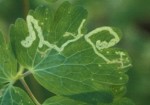 Have you ever noticed the light colored squiggly lines on the leaves of your favorite plant? Chances are they are caused by leaf miners. Leaf miners are the larvae of various insects that eat the internal tissues of leaves. Most leaf miners are the larvae of moths, sawflies,or flies, although a few are beetles or wasps. Learning more about these pests can aid you in controlling them.
Have you ever noticed the light colored squiggly lines on the leaves of your favorite plant? Chances are they are caused by leaf miners. Leaf miners are the larvae of various insects that eat the internal tissues of leaves. Most leaf miners are the larvae of moths, sawflies,or flies, although a few are beetles or wasps. Learning more about these pests can aid you in controlling them.
Here are some interesting facts about leaf miners:
 Larvae feed on palisade cells, parenchyma, and sap inside the leaf.
Larvae feed on palisade cells, parenchyma, and sap inside the leaf.
 Most larvae live entirely in the leaf but pupate in the soil, or on the outside of a leaf.
Most larvae live entirely in the leaf but pupate in the soil, or on the outside of a leaf.
 Leaf miners are spread in the spring by adult females laying their eggs in or on the underside of leaves, depending on the species.
Leaf miners are spread in the spring by adult females laying their eggs in or on the underside of leaves, depending on the species.
 Mines may be linear, blotched, or a combination of linear and blotched.
Mines may be linear, blotched, or a combination of linear and blotched.
 Each kind of insect larvae produces a characteristic mine that are often used as an aid in the identification of the larvae producing it.
Each kind of insect larvae produces a characteristic mine that are often used as an aid in the identification of the larvae producing it.
 Leaf miners produce waste as they feed called frass that is also used as an aid in identification.
Leaf miners produce waste as they feed called frass that is also used as an aid in identification.
 Mines are unattractive but rarely result in significant damage to the plant.
Mines are unattractive but rarely result in significant damage to the plant.
 The life cycle generally takes 18-21 days.
The life cycle generally takes 18-21 days.
 There may be one or many generations per year, depending on the specific leaf miner.
There may be one or many generations per year, depending on the specific leaf miner.
 Leaf miners are most common in the tropics and least common in high mountains or Arctic zones.
Leaf miners are most common in the tropics and least common in high mountains or Arctic zones.
 Vegetable plants susceptible to leaf miniers include beans, cabbage, lettuce, peppers, tomatoes, spinach, chard, carrot, celery, cabbage, broccoli, cucumber, eggplant, leek, melon, peas, potato, okra, onion
Vegetable plants susceptible to leaf miniers include beans, cabbage, lettuce, peppers, tomatoes, spinach, chard, carrot, celery, cabbage, broccoli, cucumber, eggplant, leek, melon, peas, potato, okra, onion
 Fruit crops that are susceptible to leaf miners include citrus, blackberries, apple
Fruit crops that are susceptible to leaf miners include citrus, blackberries, apple
 Ornamental trees and shrubs susceptible to leaf minor include boxwood, holly, arborvitae, aspen, azalea, birch, basswood, cottonwood, dogwood, elm, oak, lilac.
Ornamental trees and shrubs susceptible to leaf minor include boxwood, holly, arborvitae, aspen, azalea, birch, basswood, cottonwood, dogwood, elm, oak, lilac.
 Herbaceous ornamentals susceptible to leaf minor include columbine, butterfly weed, chrysanthemum, cineraria, delphinium, gerbera daisy, impatiens, mist flower, verbena, water lily, larkspur ,aconite, marigolds, aster, ageratum, calendula, dahlia, daisy, gypsophilia, petunia, snapdragon, sunflower zinnia
Herbaceous ornamentals susceptible to leaf minor include columbine, butterfly weed, chrysanthemum, cineraria, delphinium, gerbera daisy, impatiens, mist flower, verbena, water lily, larkspur ,aconite, marigolds, aster, ageratum, calendula, dahlia, daisy, gypsophilia, petunia, snapdragon, sunflower zinnia
Since few plants are killed by leaf miners the desire to get rid of them is more aesthetic . Even when leaf miners attach leafy vegetables such as spinach or lettuce, the good portion of the leaf can be eaten and the tunneled part thrown away. Here the most practical ways to eliminate or reduce the number of leaf miners but remember, not all leaf miners are the same and some techniques work better than others depending on the leaf miner involved.
 Pick off and destroy infected leaves before the larvae can pupate. This won’t save the infected leaves but it will prevent the next generation from being produced.
Pick off and destroy infected leaves before the larvae can pupate. This won’t save the infected leaves but it will prevent the next generation from being produced.
 Apply plastic mulch around infected plants to prevent larvae from dropping in the ground a pupating.
Apply plastic mulch around infected plants to prevent larvae from dropping in the ground a pupating.
 Use yellow sticky traps to reduce the number of laying females
Use yellow sticky traps to reduce the number of laying females
Less practical but possible ways are:
 Introduce the parasitic wasp Diglyphus isaea
Introduce the parasitic wasp Diglyphus isaea
 Spray insecticide to kill the adult insects before they lay their eggs
Spray insecticide to kill the adult insects before they lay their eggs
N.B. Spraying infected leaves does little good since the leaf surface protects the leaf miner within.
